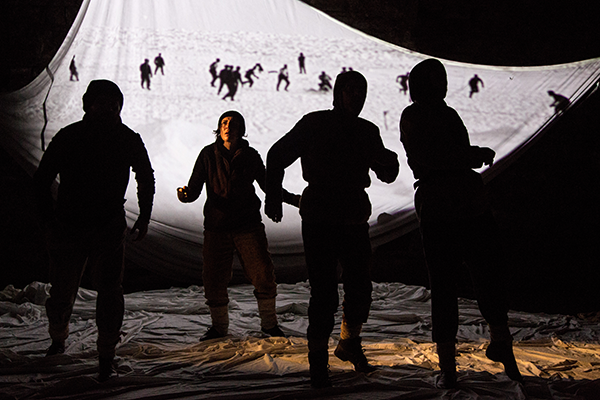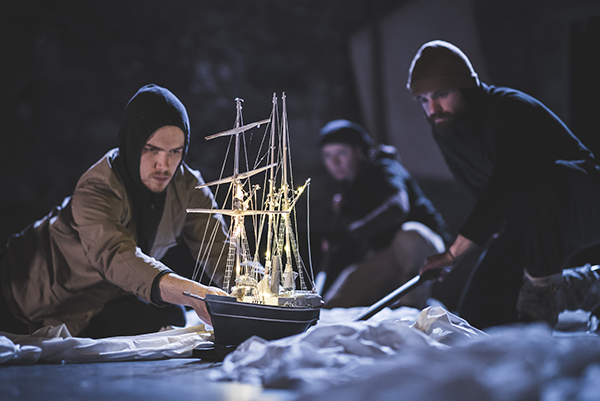Blue Raincoat Theatre Company
Project Arts Centre, Dublin
27 February–11 March 2017
By Tony Canavan
Blue Raincoat is one of Ireland’s longest-running theatre ensembles, with a reputation for innovative, imaginative productions. Shackleton is their latest, described as ‘a visual theatre piece, the tale of the Irish explorer Ernest Shackleton’s escape from the Antarctic is told by an ensemble cast, complemented by original footage and scaled puppetry’. The theatrical piece is the work of dramaturge Jocelyn Clarke, and the ensemble consists of John Carty, Barry Cullen, Brian F. Devaney and Sandra O Malley. I have to admit that I am something of a Shackleton buff and was looking forward to this play.
We have to consider this production from two points of view. First, does it succeed as a theatrical piece? Second, is it an authentic retelling of Shackleton’s story? As this is theatre, it must be borne in mind that dramatic ‘truth’ is not the same as historical fact, as characters and events may have to be manipulated to convey the story and its message in a dramatic way. Nevertheless, the play is based on real historical events and, since this is a history magazine, it behoves us to consider how close to the actual story it is.
As a piece of drama the emphasis is on the visual, as there is no dialogue; the actors do not portray specific characters—there is no ‘Shackleton’—but rather collectively portray the crew of the Endurance, the ship at the centre of it all. The set is minimalist, consisting of sheets of white cloth and a few props. The visual aspect is enhanced by the projection on a back sheet of photographs taken at the time by Frank Hurley and of sentences at the opening and closing of the production.
The action is conveyed by the four actors using scale (i.e. very small) models of firstly the Endurance and then of the three lifeboats that were used by the crew to sail away when the ship was crushed by the ice. Later, when depicting the episode of Shackleton, Worsley and Crean crossing the mountains of South Georgia (represented by brown sheets), three tiny dolls are employed. The actors move the sheets of cloth and the models (which are lit internally) around the stage to convey what is happening.

At one level this was impressive. The silence of the actors and their slow controlled movements could be said to invoke Japanese Noh theatre. The fact that traditionally plots in Noh theatre are drawn from legend, history, literature and contemporary events heightens the comparison with this historical piece. In parts, too, Shackleton resembles Wayang, Javanese shadow puppet theatre, both because the cast manipulate the scenery and the models to create the effects of movement, and because in some scenes the actors are presented in silhouette, as light projects their shadows onto the walls of a tent.

Another dimension is added to the action by the judicious use of sound effects. These recreate the creaking and groaning of the ice as it closes in on and eventually crushes the Endurance, the harsh weather and the towering waves that Shackleton and his men had to endure as they attempted to reach safety across the Weddell Sea. The unflinching morale of the men is evoked by the playing of a record on a hand-cranked gramophone—although I’m pretty sure the record would not have been ‘The Wearing of the Green’.

It has to be admitted that this was not to everyone’s taste and my own patience was tried. At about fifteen minutes into the production, attention began to wander; some members of the audience began to talk (in whispers) among themselves, and I am pretty sure that I heard the sound of someone sleeping at the other end of the theatre. The lighting, or lack of, was a major problem. For huge chunks of the play, the only light on stage was that generated by the fairy lights on the models, making it very difficult to make out just what was going on. There was a major gaffe in stage direction, as much of the action occurred downstage close to the front row of the audience. With the stage being flush with the floor and the pitch of the seating quite shallow, from where I was sitting I could just make out the actors and their props through the heads of those in the front row, and I am sure that people sitting behind me could see little or nothing. Having said all that, the audience duly applauded at the end and gave the cast three curtain calls.
Did it work from a historical point of view? The first thing to say is that Blue Raincoat seem to have assumed that we all knew the Shackleton story, and not just the broad details. A stranger to Shackleton would have left the theatre with the notion that he and his men were trapped on ice and managed to escape, but not much else. As a tableau vivant of the events the play was adequate, but really seemed to have missed the point. Shackleton’s story is an ultimately upbeat one: unlike Robert Scott’s fateful and catastrophic last expedition, Shackleton overcame huge odds and got everyone back alive. I didn’t get that sense of achievement from this production.
Added to this, the very essence of Shackleton’s success as a leader was his way with words. From knowing what to say in a simple conversation to delivering a rousing speech in the face of disaster, it was his language that marked him out as an exceptional man-manager. On the Endurance he was surrounded by men like Frank Worsley and Frank Hurley, who were full of wit. When stuck in their tents, the men passed the time and kept up their morale by telling stories and singing songs. Yet this production deprived these men of this essential quality, and that for me was its biggest failure.
Tony Canavan is editor of Books Ireland.
